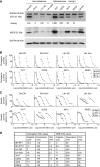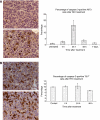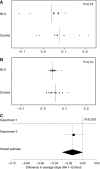Preclinical efficacy of the bioreductive alkylating agent RH1 against paediatric tumours
- PMID: 19491903
- PMCID: PMC2713707
- DOI: 10.1038/sj.bjc.6605100
Preclinical efficacy of the bioreductive alkylating agent RH1 against paediatric tumours
Abstract
Background: Despite substantial improvements in childhood cancer survival, drug resistance remains problematic for several paediatric tumour types. The urgent need to access novel agents to treat drug-resistant disease should be expedited by pre-clinical evaluation of paediatric tumour models during the early stages of drug development in adult cancer patients.
Methods/results: The novel cytotoxic RH1 (2,5-diaziridinyl-3-[hydroxymethyl]-6-methyl-1,4-benzoquinone) is activated by the obligate two-electron reductase DT-diaphorase (DTD, widely expressed in adult tumour cells) to a potent DNA interstrand cross-linker. In acute viability assays against neuroblastoma, osteosarcoma, and Ewing's sarcoma cell lines RH1 IC(50) values ranged from 1-200 nM and drug potency correlated both with DTD levels and drug-induced apoptosis. However, synergy between RH1 and cisplatin or doxorubicin was only seen in low DTD expressing cell lines. In clonogenic assays RH1 IC(50) values ranged from 1.5-7.5 nM and drug potency did not correlate with DTD level. In A673 Ewing's sarcoma and 791T osteosarcoma tumour xenografts in mice RH1 induced apoptosis 24 h after a single bolus injection (0.4 mg/kg) and daily dosing for 5 days delayed tumour growth relative to control.
Conclusion: The demonstration of RH1 efficacy against paediatric tumour cell lines, which was performed concurrently with the adult Phase 1 Trial, suggests that this agent may have clinical usefulness in childhood cancer.
Figures





Similar articles
-
Pharmacological properties of a new aziridinylbenzoquinone, RH1 (2,5-diaziridinyl-3-(hydroxymethyl)-6-methyl-1,4-benzoquinone), in mice.Biochem Pharmacol. 2000 Apr 1;59(7):831-7. doi: 10.1016/s0006-2952(99)00391-3. Biochem Pharmacol. 2000. PMID: 10718341
-
Development of a new isogenic cell-xenograft system for evaluation of NAD(P)H:quinone oxidoreductase-directed antitumor quinones: evaluation of the activity of RH1.Clin Cancer Res. 2004 May 1;10(9):3147-55. doi: 10.1158/1078-0432.ccr-03-0411. Clin Cancer Res. 2004. PMID: 15131056
-
Cytotoxicity of the bioreductive agent RH1 and its lack of interaction with radiation.Radiother Oncol. 2004 Mar;70(3):311-7. doi: 10.1016/j.radonc.2003.12.008. Radiother Oncol. 2004. PMID: 15064018
-
DT-diaphorase: a target for new anticancer drugs.Cancer Treat Rev. 2004 Aug;30(5):437-49. doi: 10.1016/j.ctrv.2004.01.002. Cancer Treat Rev. 2004. PMID: 15245776 Review.
-
Chemotherapy for osteosarcoma and Ewing's sarcoma.Acta Orthop Scand Suppl. 1997 Feb;273:120-5. doi: 10.1080/17453674.1997.11744716. Acta Orthop Scand Suppl. 1997. PMID: 9057601 Review. No abstract available.
Cited by
-
Characterization of aziridinylbenzoquinone DNA cross-links by liquid chromatography-infrared multiphoton dissociation-mass spectrometry.Chem Res Toxicol. 2010 Jun 21;23(6):1097-104. doi: 10.1021/tx1000738. Chem Res Toxicol. 2010. PMID: 20369834 Free PMC article.
-
Real-time monitoring of cisplatin cytotoxicity on three-dimensional spheroid tumor cells.Drug Des Devel Ther. 2016 Jul 4;10:2155-65. doi: 10.2147/DDDT.S108004. eCollection 2016. Drug Des Devel Ther. 2016. PMID: 27445462 Free PMC article.
-
The anti-tumour compound, RH1, causes mitochondria-mediated apoptosis by activating c-Jun N-terminal kinase.Br J Pharmacol. 2011 Jun;163(3):567-85. doi: 10.1111/j.1476-5381.2011.01233.x. Br J Pharmacol. 2011. PMID: 21250978 Free PMC article.
-
PAX3 in neuroblastoma: oncogenic potential, chemosensitivity and signalling pathways.J Cell Mol Med. 2014 Jan;18(1):38-48. doi: 10.1111/jcmm.12155. Epub 2013 Nov 4. J Cell Mol Med. 2014. PMID: 24188742 Free PMC article.
References
-
- Beall HD, Murphy AM, Hargreaves RHJ, Butler J, Ross D (1995) Nicotinamide adenine dinucleotide (phosphate):quinine oxidoreductase (DT-diaphorase) as a target for bioreductive antitumor quinones: quinine cytotoxicity and selectivity in human lung and breast cancer cell lines. Mol Pharmacol 48: 499–504 - PubMed
-
- Begleiter A, Leith MK, Patel D, Hasinoff BB (2007) Role of NADPH cytochrome P450 reductase in activation of RH1. Cancer Chemother Pharmacol 60: 713–723 - PubMed
-
- Berardini MD, Souhami RL, Lee CS, Gibson NW, Butler J, Hartley JA (1993) Two structurally related diaziridinylbenzoquinones preferentially cross-link DNA at different sites upon reduction with DT-diaphorase. Biochemistry 32: 3306–3312 - PubMed
-
- Bligh HF, Bartoszek A, Robson CN, Hickson ID, Kasper CB, Beggs JD, Wolf CR (1990) Activation of mitomycin C by NADPH:cytochrome p-450 reductase. Cancer Res 50: 7789–7792 - PubMed
-
- Brown JM, Giaccia AJ (1998) The unique physiology of solid tumours: opportunities and problems for cancer therapy. Cancer Res 58: 1408–1416 - PubMed
Publication types
MeSH terms
Substances
Grants and funding
LinkOut - more resources
Full Text Sources
Medical

